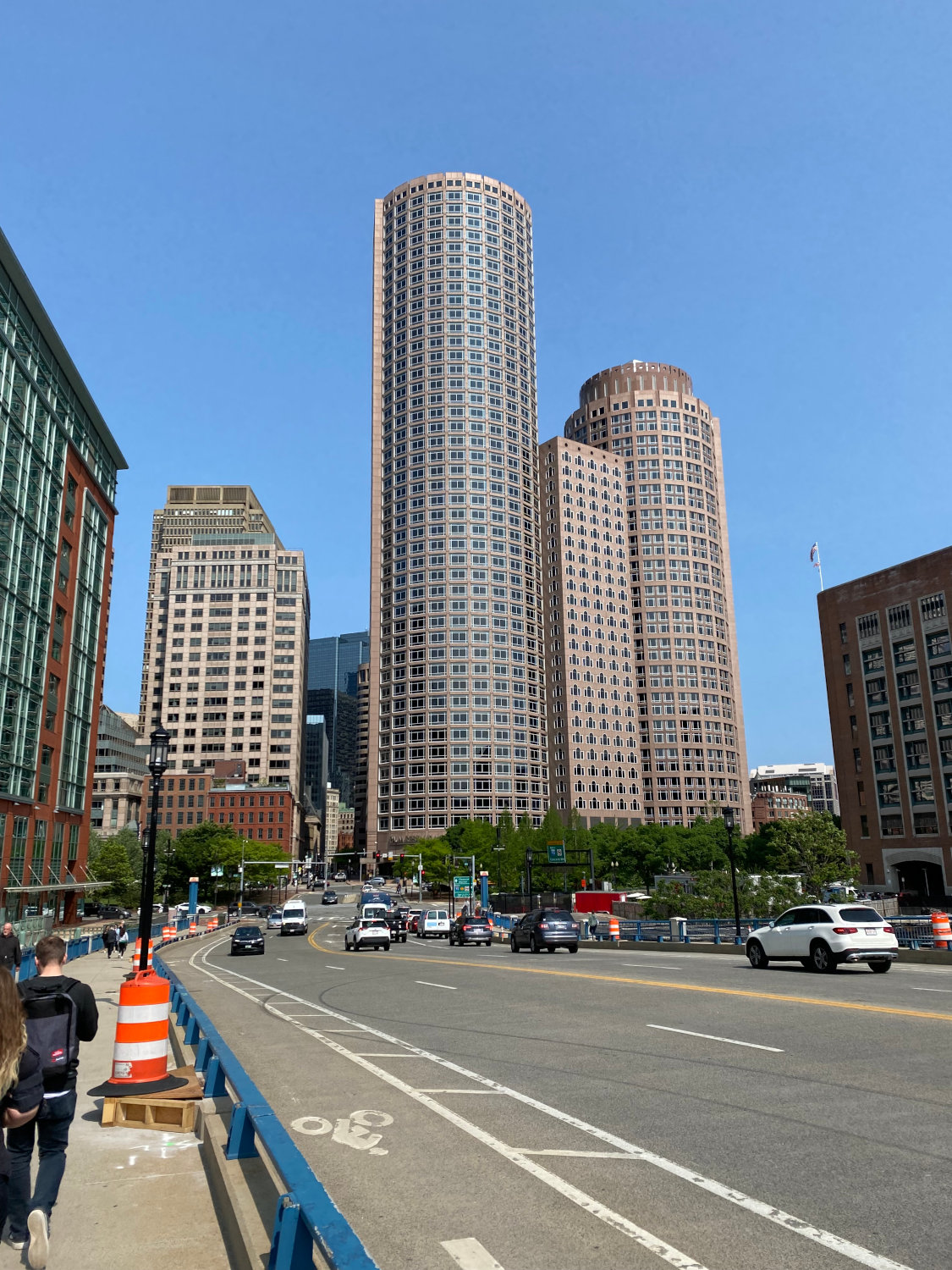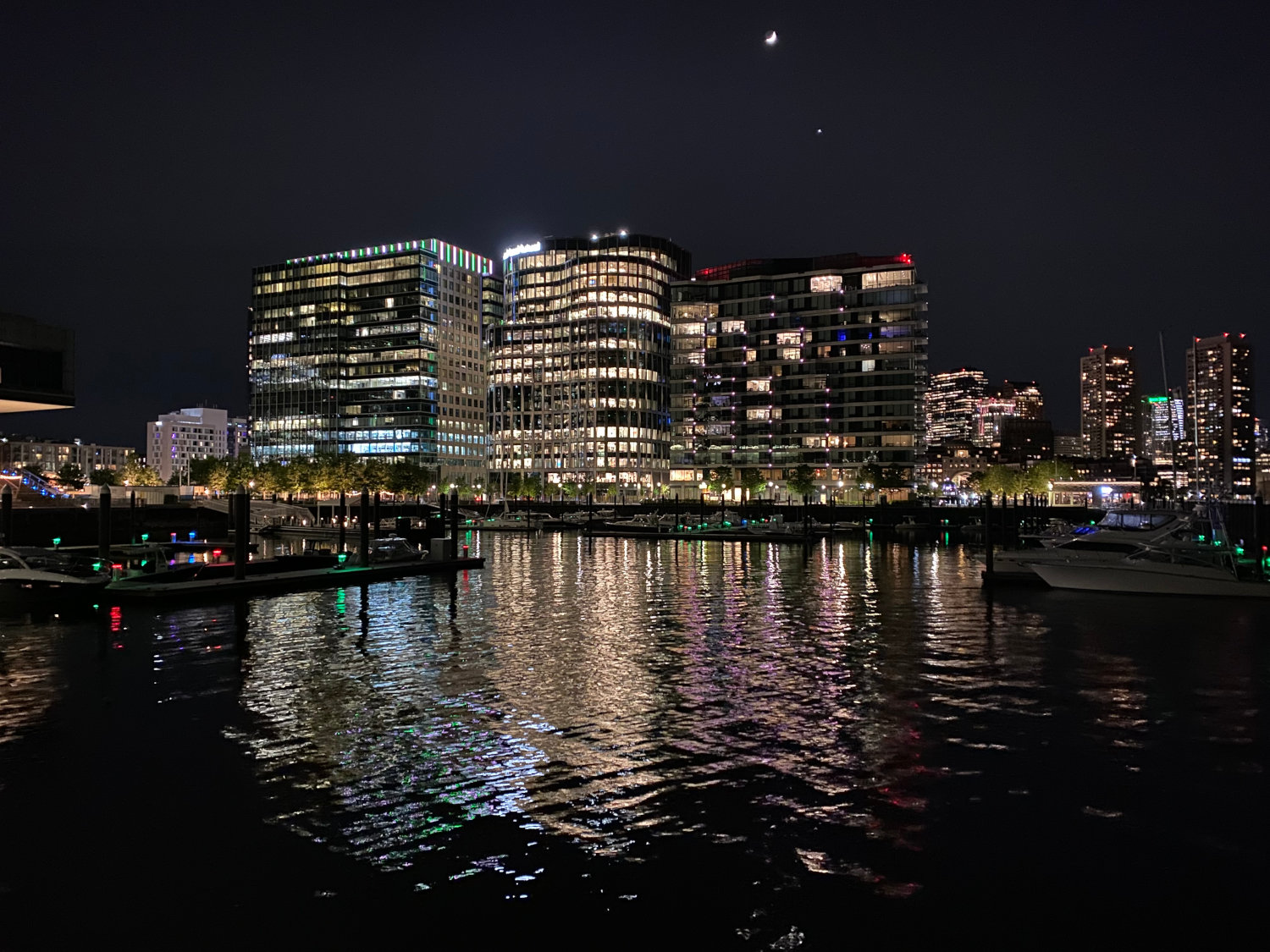Red Hat Summit 2023
From 23.05 to 25.05 the Red Hat Summit took place in Boston. The manufacturer's own conference thus took place - for well-known reasons - for the first time since 2020 in presence. For me it was the first Red Hat conference.
On the occasion of Red Hat Summit 2023, a three-part special was published in the FOCUS ON: Linux Podcast. In addition to a wrap-up, there are also interviews on oVirt and RHEL and UX and Fedora.
Location
The event took place at the Boston Convention & Exhibition Center. At just under 5 acres in size, the venue offers an enormous amount of space, which was also needed for the 350 talks and workshops on offer, as well as the numerous hands-on labs. It's very easy to get lost - the Red Hat Event Guide app offered is mandatory to keep track of everything. It is also definitely recommended to add the desired talks to the calendar before the conference starts - also for logistical reasons. Especially popular lectures were already fully booked before the kickoff.
Also quickly sold out was the merchandising in the Cool Stuff Store - here the purchase was worthwhile if you were fast enough. The items on offer can also be ordered online, but here you have to factor in high shipping and customs costs. In the exhibition area there were community booths (among others Ansible, Foreman, Fedora) as well as numerous manufacturers who answered questions and presented new products.
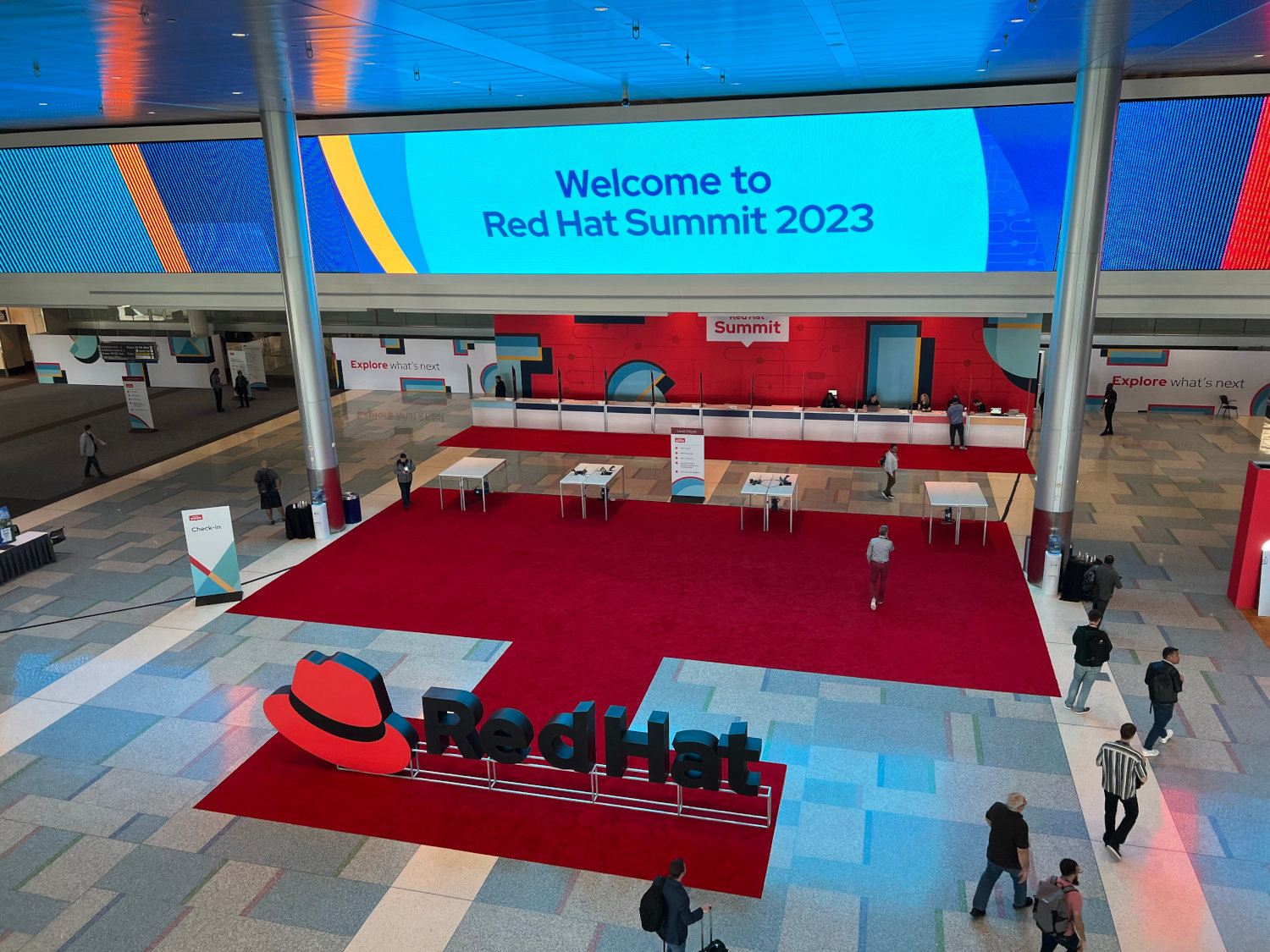
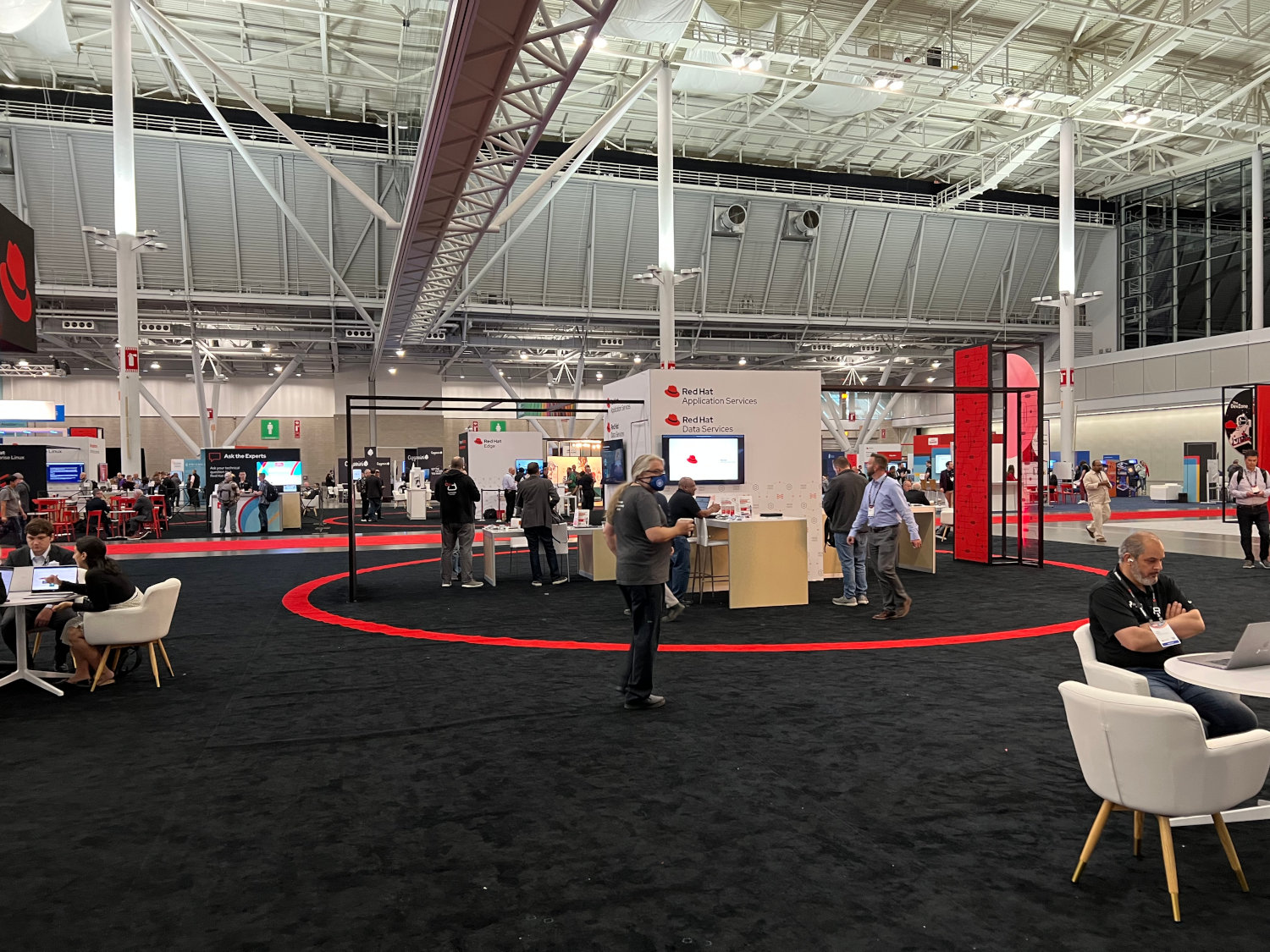

At one of the Red Hat Community booths, books were being signed. A colleague and I were lucky enough to get the last two copies of Daniel Walsh' "Podman in Action" book and had a few words with him.
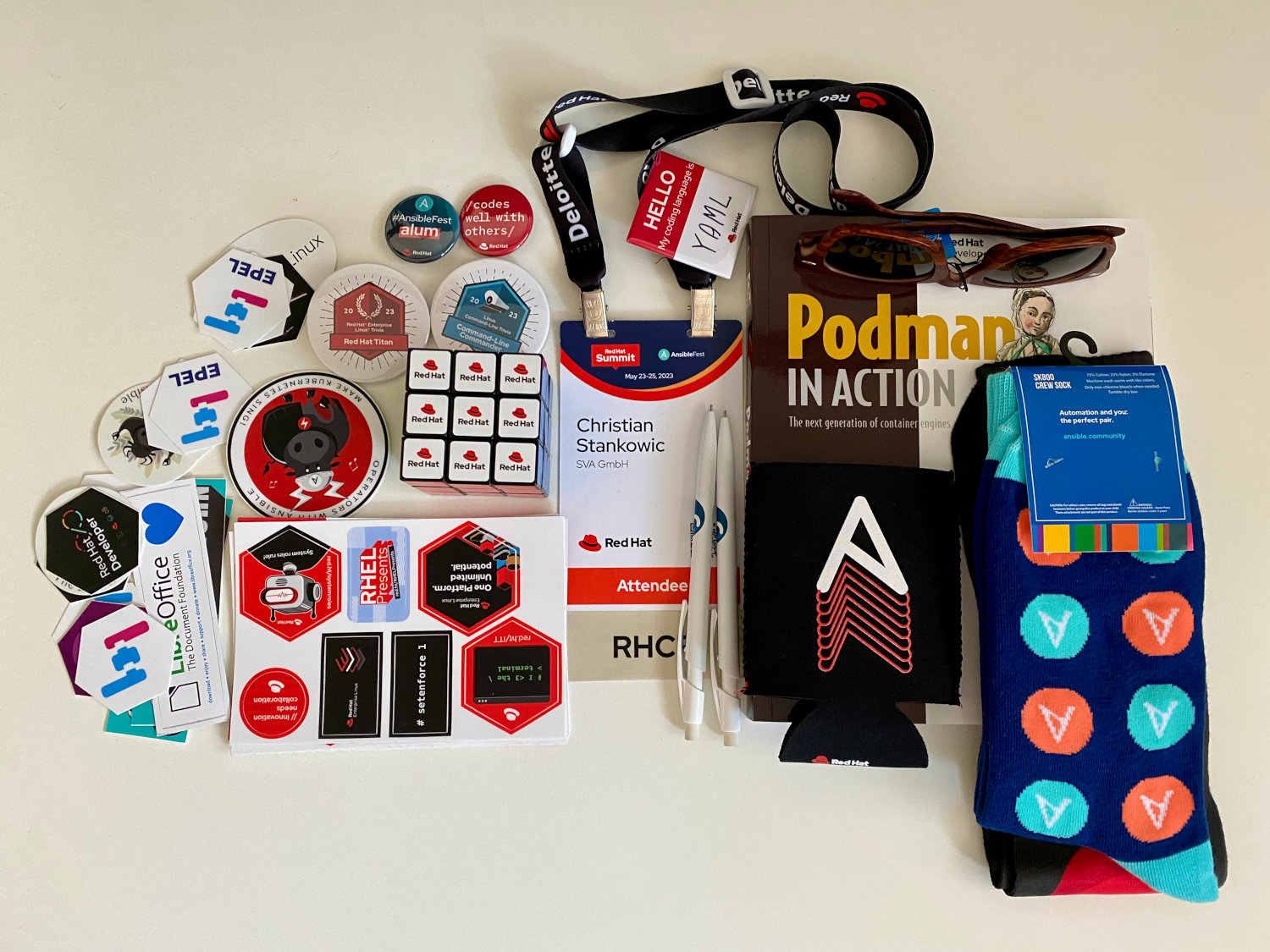
Keynotes
Right in the first keynote "Innovation doesn't rely on your IT budget" the main theme of the conference was set: AI.
Matt Hicks (President and CEO) stated artificial intelligence has evolved from a gimmick to a ubiquitous technology. Innovative solutions allow for further time savings and have created an entirely new industry with momentum. In addition to Ansible, Red Hat said OpenShift, in particular, will benefit from specially trained models to make the technology more accessible. With Ansible Lightspeed, OpenShift AI and OpenShift Data Science, no less than three add-on products were unveiled that are currently in development.
GitHub Copilot users may have noticed certain parallels with the Ansible Lightspeed demo, as Lightspeed also completes comments into deployable code. Compared to Copilot or GPT, however, you should expect a higher code quality, since the training material was selected by Red Hat and not blindly using public code from the Internet (we all know how good it is 🙄).
OpenShift AI provides the infrastructure based on OpenShift needed to train and run AI and machine learning models. In addition to cloud environments, edge and airgapped scenarios are to be supported. Models pre-trained with partners are to simplify the start - only fine-tuning needs to take place here. Approximately 30 partner companies are currently part of Red Hat's AI/ML ecosystem. Chris Wright (CTO and Senior VP, Global Engineering) proudly presented a first Customer Success Story of the German IT service provider Atruvia. This is primarily in the banking sector and is already using the technology.
OpenShift Data Science is intended to help Data Scientists in particular to better focus on development. To this end, the usual OpenShift complexity (YAML, Helmcharts) is to be dispensed with. Designed for hybrid clouds, the product dramatically simplifies the deployment of supported sandbox environments for developing, training and testing machine learning models. Designed as an addon, it can be easily installed with the click of a mouse.
A dashboard can be used to deploy various supported tools, such as JupyterHub, OpenShift Streams for Apache Kafka or IBM Watson Studio. All technical details required for this (deployment, resources, etc.) are completely abstracted. Numerous tutorials and documentation can be consumed in the dashboard. The product will be available as a Technology Preview from the end of June.
YouTube has a demonstration of the technology.
With Red Hat Service Interconnect, a tool based on Skupper was introduced, which is used to connect apps and services across different Kubernetes clusters. It works on OSI layer 7 and requires neither VPNs nor special firewall rules. In other words, Skupper allows applications to span multiple data centers and cloud providers.
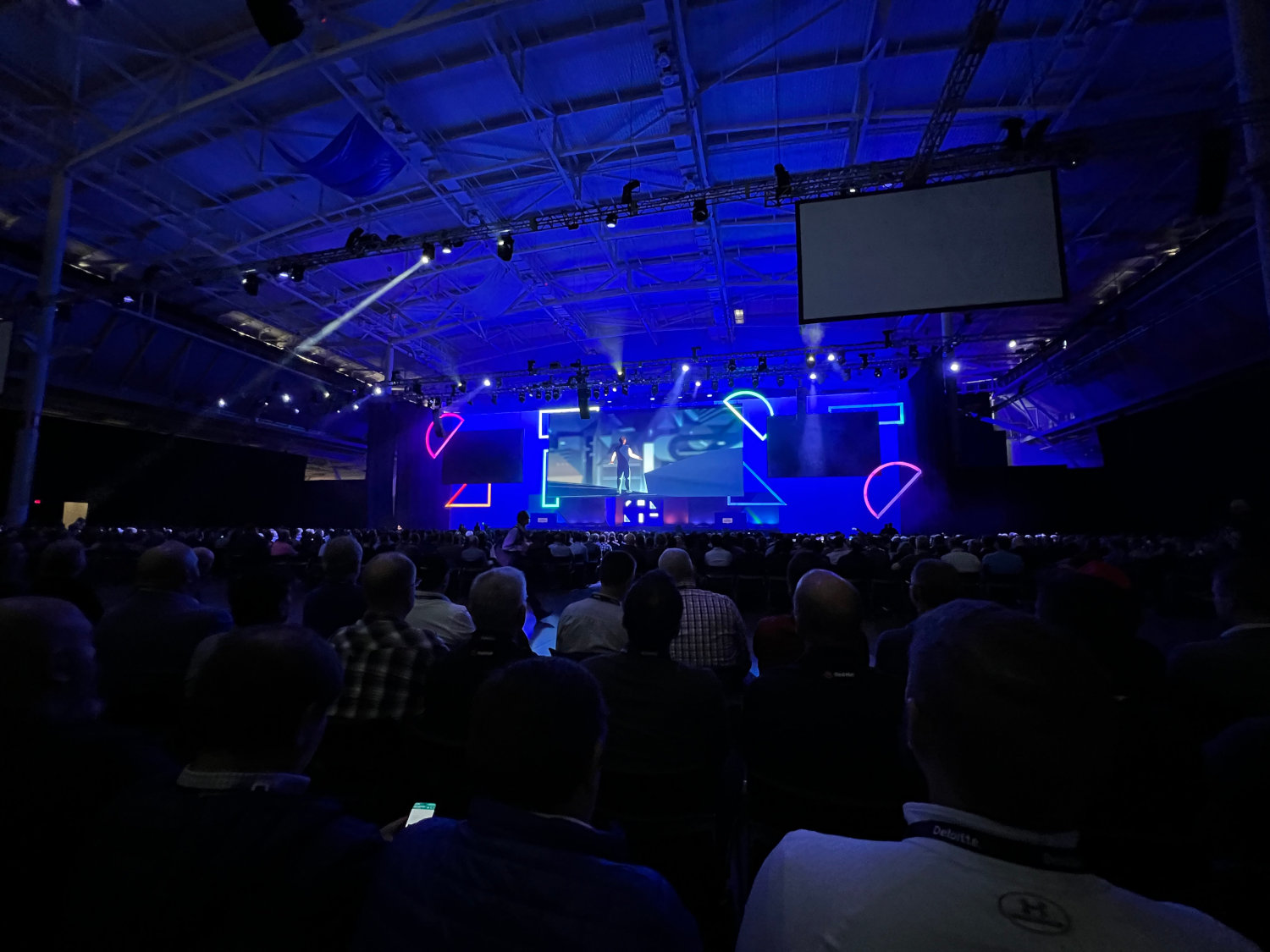
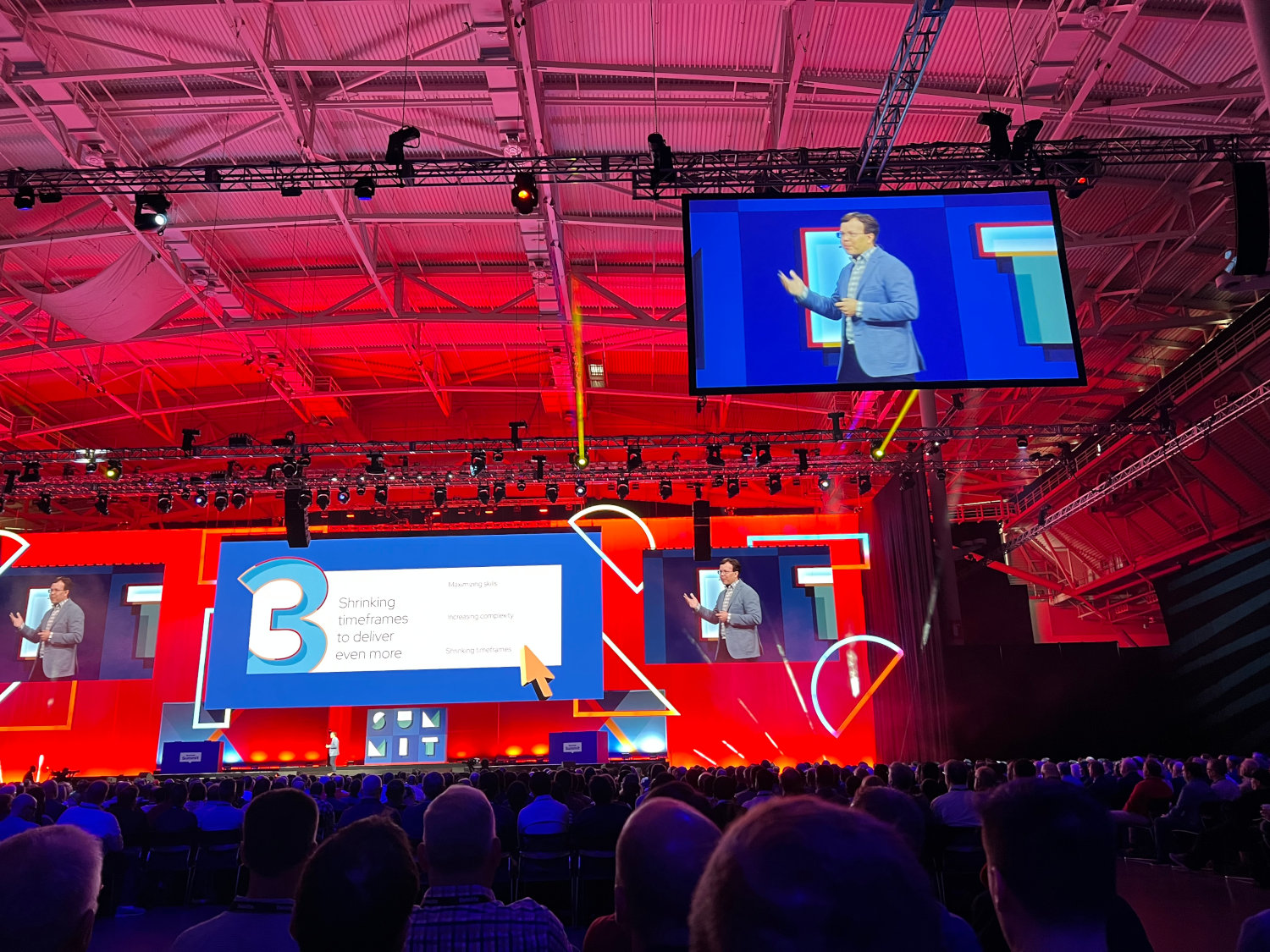

The second keynote, "Optimize to innovate at scale," was all about the numerous partnerships that Red Hat maintains. So Stefanie Chiras (Senior VP, Partner Ecosystem Success, Red Hat), Ruba Borno (VP World Wide Channels and Alliances, AWS), Gene Reznik (Senior VP, Ecosystem and Industries, Celonis) and Todd Pavone (President, Strategic Partnerships, DELL Technologies) talked mainly about joint projects and challenges.
Significantly more interesting and unexpected I found the upgrade of Red Hat Insights. While the tool stood so far primarily for proactive security monitoring (CVEs, Best Practices), it is to offer in the future some features from the Red Hat Satellite environment. So host groups and patches should be able to be managed easily in the near future. The Image Builder, which has so far only been available via Cockpit, will then also be available as a service and will be able to patch and also deploy cloud images. The new functions should especially please smaller customers who are afraid of the complexity of Satellite and do not yet use a deployment tool such as HashiCorp Terraform. Fortunately, the upgrades should be available to all RHEL subscribers.
All in all, I found the keynotes interesting, even if it could have been a bit less AI to my taste. Don't misunderstand: from a technical perspective, the tools presented are very interesting and also seem to be able to offer added value. However, with the current omnipresent AI hype, the important question of efficiency and the principle of dependency often takes a back seat. Personally, I don't see myself having my Ansible code generated in large part by a language model. No question, IT has reached a level of complexity where you can't understand all the technologies in the stack, but for fundamental components - like configuration management - I don't feel good about depending on an artificial intelligence.
I find the innovations from the Event-driven Ansible (see also below) and Insights environment exciting and will take a closer look at them.
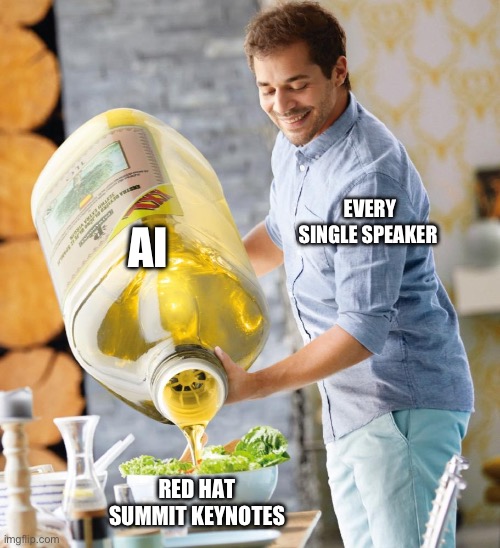
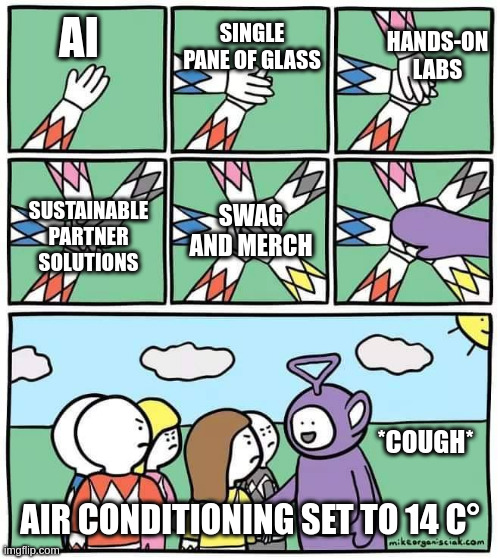
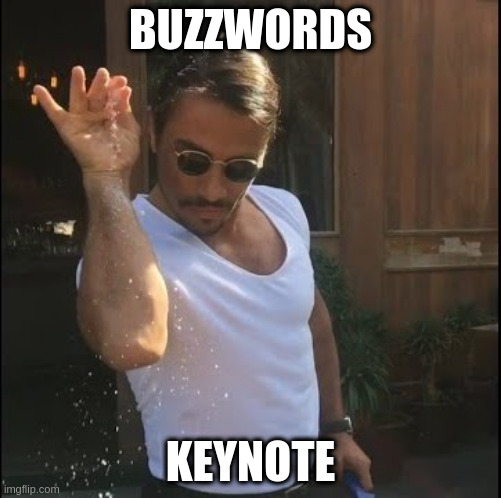
Ansible Lightspeed
Probably the biggest announcement was Ansible Lightspeed (formerly Project Wisdom). This is a project where IBM Watson Code Assistant was extended with a model trained on Ansible.
With the help of a VScode extension, task descriptions, for example, can be automatically supplemented with the desired behavior. Here, the description must be in English - other languages are currently not supported. The live demo shown was authentic - in a hands-on lab one could convince oneself of this.
More information is available in the documentation - on the following page there are slides and a hands-on lab.
The service is understood to be a Technology Preview, for which one can still register until the end of June. The service can be used for free during the development phase, as input will be used for further training. A GitHub account is required.
Molecule 6
I regularly develop Ansible roles and collections and therefore use Molecule for automated testing. Now that the project has been officially part of the Ansible community for some time, major changes are planned for Molecule 6.
In the future, the focus will be entirely on testing, which is why breaking changes are to be expected. Planned are among other things better CI/CD support as well as the automatic generation of documentation. The integration of testinfra will be dropped, only the delegated driver can be used for deployments. The central configuration file molecule.yml shall give way to Ansible variables.
The tool shall be more like the look and feel of Ansible, but VM/container deployment via Ansible shall still be possible." pytest-ansible and tox-ansible will become integral parts of the new program version.
Currently Molecule 6 is a Developer Preview, in the Ansible Automation Platform 2.4 planned for Q3 the tool should be stable.
Event-driven Ansible
Another not-so-brand-new topic was Event-driven Ansible. Here Ansible is extended by a proactive component. While Ansible previously acted reactively and was mainly executed manually or automatically at time intervals (e.g. via AWX or Ansible Automation Platform), Ansible can now react dynamically to events.
A central component of the solution are so-called rulebooks, in which events to be monitored are defined. If such an event occurs, a corresponding countermeasure can be defined - usually the execution of Ansible playbooks.
Monitoring requires plugins. Currently, 22 plugins are currently being developed by 9 partners, including:
- ServiceNow
- CyberArk
- F5
- Apache Kafka
- Prometheus/Alertmanager
If an event is received, it is forwarded to Ansible Automation Platform. There is a corresponding server component which then triggers countermeasures (Rulebook Engine). This component is outsourced as a counterpart to the Execution Environment in a so-called Decision Environment. Thus, another container exists that can be scaled accordingly - for example, to increase availability.
Rulebooks are also defined in YAML - an example:
1---
2- name: restart web server in case of error
3 host: all
4 sources:
5 - name: listen for alerts
6 ansible.eda.alertmanager:
7 host: 0.0.0.0
8 port: 8000
9 rules:
10 - name: restart web server
11 condition: event.alert.labels.job == "fastapi" and event.alert.status == "firing"
12 action:
13 run_playbook:
14 name: ansible.eda.start_app
15...
During one of the keynotes, a demo with Dynatrace was shown. The feature is still scheduled for release in June 2023.
I personally find the feature very interesting for some scenarios - for example, when "self-healing infrastructure" is needed. Until now, this functionality was a unique feature of the competing IaC software SaltStack.
For more information, see the Ansible blog, the GitHub repository, and the documentation.
Networking
The main reason why I attend conferences is to meet people that you can't meet otherwise. With international conferences, it is very beneficial to be in the same time zone for a change. Networking is important and I had a lot of fun making new contacts and bringing virtual acquaintances into physical reality for the first time.
So I had the opportunity to finally talk to Carol Chen (Ansible Community Architect) - a very nice conversation! 😀
In the Red Hat Event Guide app, you could arrange to meet new contacts based on topics - the QR codes printed on the participation badges also allowed you to exchange contact information quickly.
I was also very pleased to be able to talk to Eric "The IT Guy" Hendricks, Máirín Duffy and Matthew Miller. Eric is known as the founder of the Sudo Show podcast and host of the Fedora podcast, among other things.
Máirín is the creative mind behind much artwork and UX work in the Red Hat ecosystem as Senior Principal Interaction Designer. She has designed the logos for Podman, Podman Desktop, Buildah, and Skopeo, among others, and also illustrated the entertaining Coloring Books (SELinux, Container, Container Commandos, Reliability Nightmares).
Matthew is the project lead of the Fedora project. As a daily Fedora user, it was very interesting for me to talk with him about current and future developments.


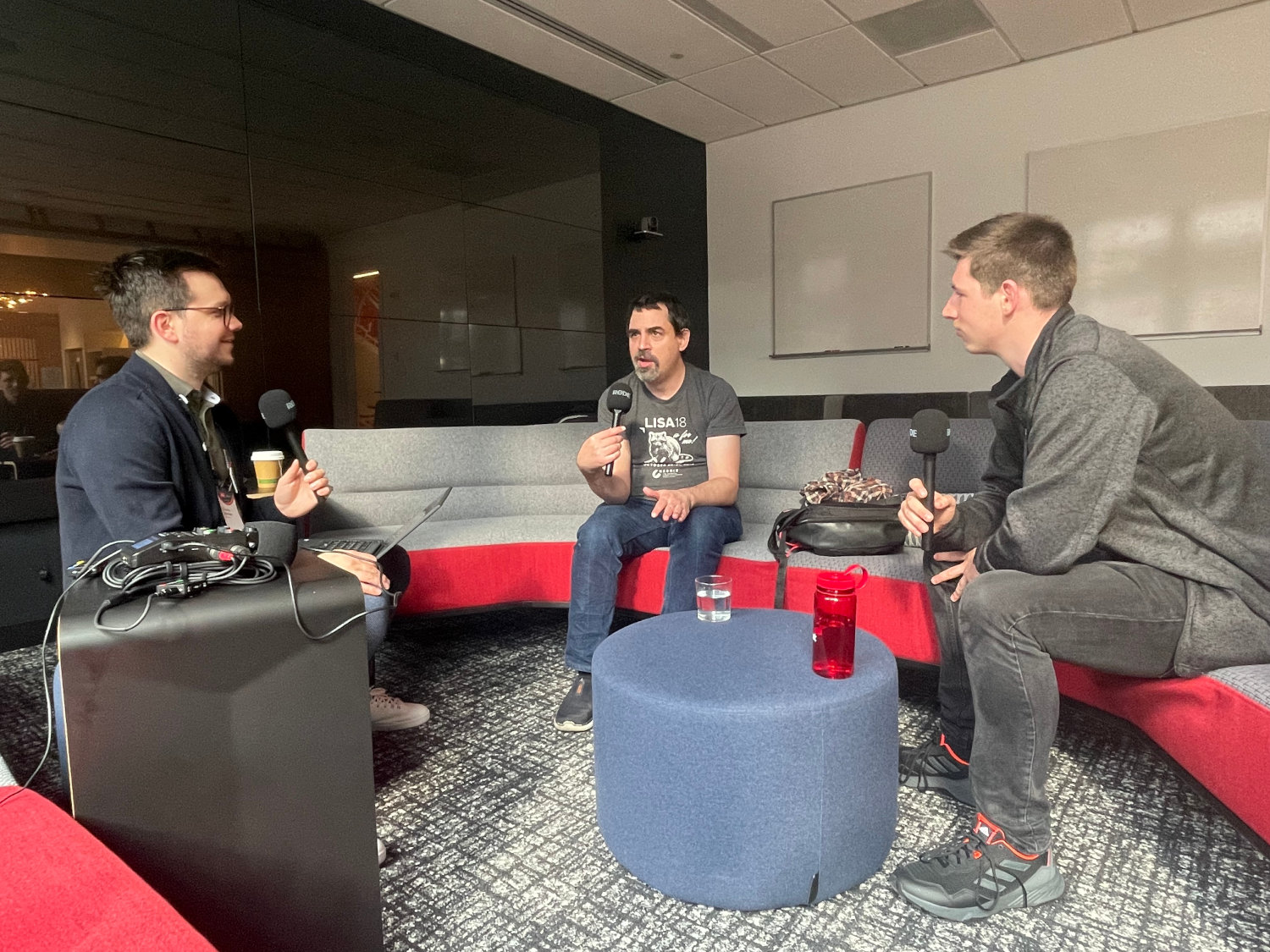
With Máirín and Matthew we were able to conduct interviews in the nearby Red Hat office - a very exciting experience that I will remember for a long time.
A small museum in the office was my personal highlight. Here you can find various historical Red Hat products and merchandise, such as T-shirts, books and stickers - there was so much to discover. I even own one of the shirts and the Red Hat Linux 6.1 Deluxe box too! 😀
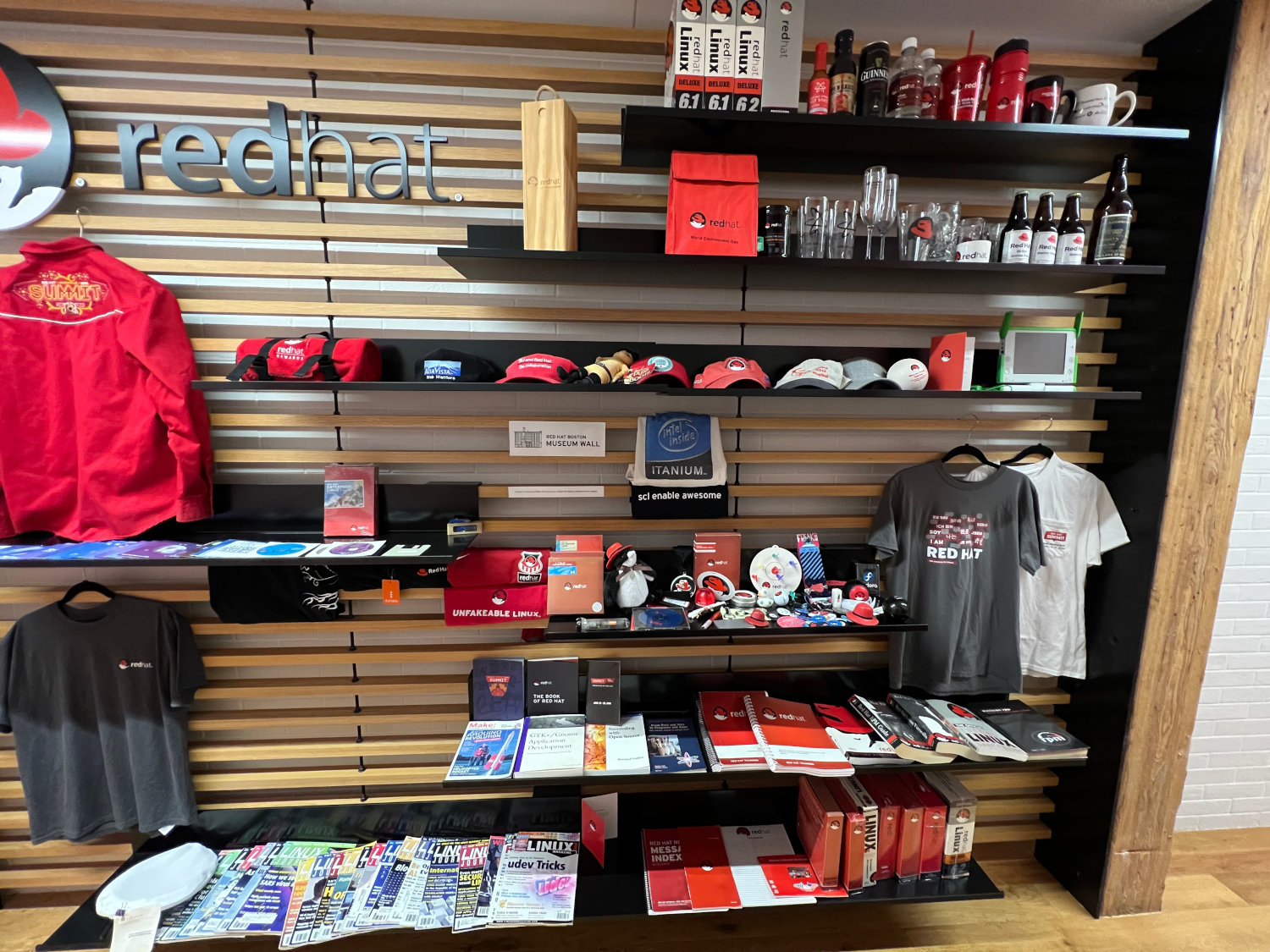
Boston
If you feel like a change of pace after hours of lectures and workshops, it is highly recommended to explore Boston. The city has a very European feel, which should appeal to travelers who have never been to the US before. Boston is one of the oldest major and port cities in the US and has a great cultural and entertainment offering.
The city is walkable, the Freedom Trail shows 16 sights of the city and a good entry point to get a rough overview. Here, you should also be sure to visit Quincy Market - a historic building that usually houses a food market. In the evening, the docks invite you to take a walk, before you can end the day in one of the countless bars.
If time permits, it is recommended to explore the peninsula Cape Cod to the north by rental car. There are numerous picturesque harbor towns with beautiful beaches - for example Provincetown. Alternatively, about 6 km from Boston are the campuses of Harvard University and the Massachusetts Institute of Technology.
